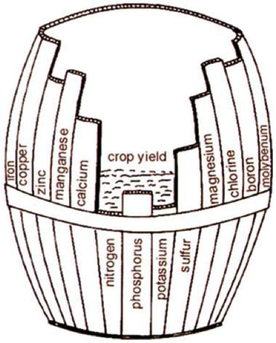During the middle of the nineteenth century, Leibig discovered the law of the Minimum.
If several nutrient elements are present in the soil in amounts that would be insufficient for maximum plant yield, the yield will be determined solely by the supply of the element that is present in the smallest amount relative to the plant requirement, increasing the supply of other elements has no effect on yield.
If several nutrient elements are present in the soil in amounts that would be insufficient for maximum plant yield, the yield will be determined solely by the supply of the element that is present in the smallest amount relative to the plant requirement, increasing the supply of other elements has no effect on yield.
Understanding of this Law of the Minimum is helped by the well known analogy of water in a wooden barrel with staves of unequal length. The heights of the individual staves represent the level of supply of nutrients that are capable of influencing the yield, while the level of water in the barrel represents the actual yield.
In the example below we see that as long as the Nitrogen supply is limiting plant yield, there will be no benefit in increasing amounts of any other element. However if the supply of Nitrogen was increased another element, in this case Potassium would be expected to become the limiting element.
In the example below we see that as long as the Nitrogen supply is limiting plant yield, there will be no benefit in increasing amounts of any other element. However if the supply of Nitrogen was increased another element, in this case Potassium would be expected to become the limiting element.

